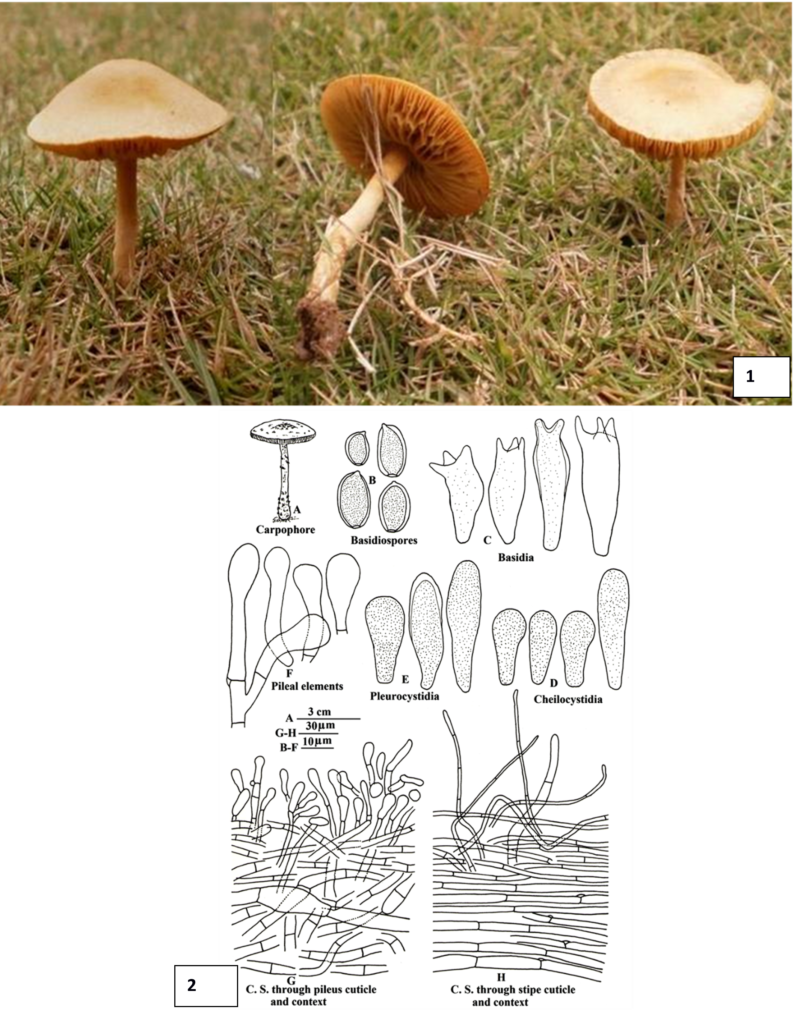Agrocybe pediades (Fr.) Fayod
MycoBank number: MB 355818; Index Fungorum Number: IF 355818; Facesoffungi Number: FoF 10428;
Agrocybe pediades (Fr.) Fayod, Annales des Sciences Naturelles Botanique, 9: 358, 1889.
Synonyms
Agaricus pusillus Schaeffer in Fung. Bavar. Palat. Nasc. 4: 45, 1774.
Agaricus semiorbicularis Bulliard in Herb. France 9: 422, 1789.
Agaricus arenicola Berkeley in London J. Bot. 2: 511, 1843.
Naucoria subpediades Murrill in Lloydia 5: 150, 1942.
Agrocybe splendida Clémençon in Nova Hedwigia 28 (1): 8, 1977.
Description
Humicolous, growing scattered on humicolous soil among grasses along roadside Sexual state: Carpophores 3.5–4.5 cm in height. Pileus 2.2–3.1 cm broad, convex, broadly umbonate; surface moist, pale orange (5A3) with brownish orange (5C4) centre; scaly, scales appressed fibrillose, cover the entire pileus; margin regular, slightly uplifting; cuticle not peeling; flesh upto 0.2 cm thick, yellowish white (4A2) unchanging; taste disagreeable; odour spicy. Pileal veil absent. Lamellae broadly adnate; unequal, in 5 lengths; branched; gills extending beyond the pileus; subdistant; narrow (0.2–0.4 cm broad); light orange (6A5), unchanging; gill edges smooth; fragile. Stipe central, 3.2–4.3 cm long, 0.2–0.3 cm broad, slightly tapering upward with bulbous base; pale orange (5A3), light orange (6A4) near the pileus, unchanging; solid; scaly, scales white, fibrillose all over the stipe, maximum near the base; exannulate. Basidiospores (10.14) 11.83–16.9 × 7.6–10.14 µm (excluding apiculus), (Q=1.6) ellipsoid, lentiform; smooth; double walled, pale brown, granular; truncated with apical germ pore; apiculate, apiculus 0.84–1.69 µm long, prominent. Basidia 25.35–37.18 × 10.14–11.83 µm, clavate, –2, –3, –4 spored, –4 spored very rare, hyaline to weakly granular; sterigmata 5.07–6.76 µm long. Pleurocystidia 27.04–40.56 × 8.45–11.83 µm, clavate, granular, double walled. Cheilocystidia 23.66–37.18 × 8.45–10.14 µm, clavate, granular, few double walled; gill edges heteromorphous. Carpophore context homoiomerous. Pileus cuticle cellular, hymeniform, made up of clavate cells with rounded apex, individual elements measuring 23.66–42.25 × 8.45–10.14 µm, branched with clamp connections, hyaline; pileus context hyphal, made up of network of 7.88–11.82 µm broad, septate hyphae; caulocystidia not seen. Hymenophoral trama regular. Stipe cuticle hyphal, made up of longitudinally tangled, 7.88–15.76 µm broad, closely septate, hyphae with few projecting 1.97–7.88 µm broad, closely septate hyphae. Clamp connections present throughout. Asexual state: not observed, but see notes.
Material examined: INDIA, growing scattered on humicolous soil among grasses along roadside, January 12, 2010, Harwinder Kaur, PUN 5924.
Distribution: Wayanad, Malappuram and Idukki in Kerala.
Notes: The macroscopic and microscopic details of the above collections are in full conformity with the details of Agrocybe pediades (Fr.) Fayod previously known as Agrocybe semiorbicularis given by Watling (1982), Watling and Taylor (1987) and by Breitenbach and Kränzlin (1995). The caulocystidia are reported from the sections cut from the apical part of the stipe only by Breitenbach and Kränzlin (1995), but in our collections the caulocystidia were not seen. Further in present collection pleurocystidia are present which are not described in the available literature. It is a well documented fungus from India named under Agrocybe semiorbicularis. Earlier Indian record was by Rawla et al. (1982) from Chandigarh; Abraham (1991) recorded it from Kashmir. Later Natarajan and Raman (1983) reported it from Tamil Nadu; Farook et al. (2013) documented it in a checklist of agarics from Kerala, India that Mohanan (2011) and Thomas and Manimohan (2003) reported this as Agrocybe temulenta (Fr.) Singer which is distributed over Wayanad, Malappuram and Idukki in Kerala. The present documentation of species is first of its kind from district Patiala of Punjab. Consumption Habit: It is an edible fungus according to Wood & Stevens (1997–2013). But according to Phillips (2001–2013), it is too small and easily confused with other Little Brown Mushrooms and hence is a poisonous suspect too, thus should be avoided.

Fig. 1– 2 Cyclocybe parasitica (G. Stev.) Vizzini: 1 Carpophores growing in their natural habitat. 2 Camera Lucida drawings (A Carpophores. B Basidiospores. C Basidia. D Cheilocystidia. E Pileocystidia. F Caulocystidia. G C. S. through pileus cuticle & context. H C. S. through stipe cuticle & context).
